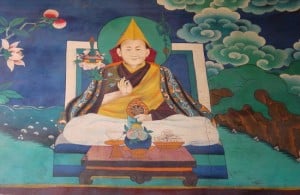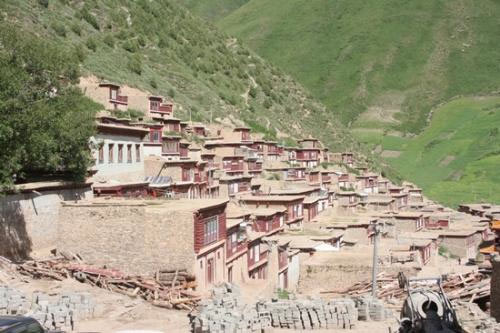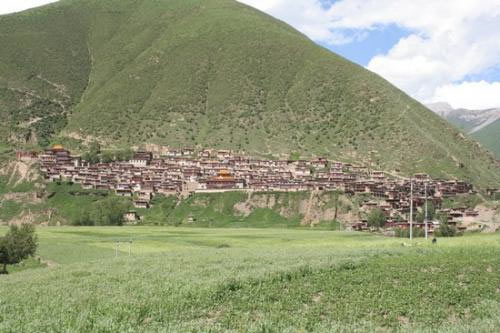
A hidden mural of the Dalai Lama in Lhasa. The Chinese authorities’ virulent rhetoric against the Dalai Lama and heavy-handed imposition of religious restrictions are significant factors in the wave of protests in Tibet today. (ICT)
The protests appeared to be sparked by the arrival of an official work team to the Tongkor (Chinese: Donggu) monastery 60 kilometers from Kardze (Chinese: Ganzi) town in western Sichuan (the Tibetan area of Kham), which was unaffected by recent unrest in Tibetan areas until now. The Chinese officials told monks that they should denounce the Dalai Lama, and oppose the ongoing demonstrations against Chinese rule, and the monks objected. According to one reliable report, “skirmishes” broke out and officials started searching monks’ quarters for images of the Dalai Lama.
“At one point, some officials apparently threw pictures of the Dalai Lama and of the monastery’s exile tulku, Tongkor Shabdrung, on the ground, according to reliable sources. A monk in his seventies, Tsultrim Tenzin, and another monk in his late twenties, Yeshe Nyima, protested about the work team’s actions, and later, the monks were told that they had to denounce the Dalai Lama. The incident escalated after monks objected when Tsultrim Tenzin, and later, Yeshe Nyima, were taken into custody.
Many or most of the 350-strong monastic community began a protest, joined by some laypeople, calling for the Dalai Lama to return home and for the release from detention of the monks from Tongkor, according to several reliable Tibetan sources with connections to the area. Armed police were deployed and shot at the crowd, killing at least eight Tibetans. Some monks were reportedly injured by gunfire, and more than ten monks are reportedly missing. An unnamed number of witnesses told Radio Free Asia today that they believed 15 people were killed and dozens injured, with scores more unaccounted for as of April 4. According to Radio Free Asia and ICT sources, those reported killed in the shooting include three monks, Samten, 27, Lobsang Rinchen, in his 20s, and Zunde; a man named Phurbu Delek, 30; six women identified as Sangmo, 34, Tenlo, 32, Tsering Yangzom, Tseyang Kyi, 23, Druklot Tso, 34, and Tsering Lhamo; and a young boy. Two monks, Nyima and Thubten Gelek, were described by sources to Radio Free Asia’s Tibetan Service as “seriously injured.”
Radio Free Asia’s Cantonese service was told by a source: “One monk has been killed, and seven Tibetans. Yesterday morning the police came to some Tibetan houses and asked them not to mourn those Tibetans who died in earlier clashes, and not to post the Dalai Lama’s pictures. Then they had a clash with the police. Many people have been beaten up and arrested.”(Radio Free Asia Tibetan service report, April 4). The same report quoted a Chinese resident who said the unrest had been broadcast on television, saying: “It wasn’t a protest. It was beating, smashing, and looting, like bandits. They couldn’t have fired shots-from what I saw on television, the police were very restrained, talking to them, advising them.”
Although the Chinese resident’s account could not be confirmed, the state media reported that a ‘riot’ took place outside government offices in the Kardze Tibetan Autonomous Prefecture, saying that one government official was “attacked and seriously wounded” and that police were “forced to fire warning shots and put down the violence.”(Xinhua, April 4).
In a statement two days ago giving “evidence” that the “Dalai clique” had incited the recent protests and riots in Tibet, the Chinese authorities singled out Kardze as a particular area of political concern, indicating that dissent in the region would be likely to be met by severe reprisals. The People’s Daily (English language version) stated: “Garze Tibetan Autonomous Prefecture in Sichuan province is regarded by the Dalai clique as a ‘model area’ for secessionist activities.” (April 2).
Tibetans have responded in other areas of Tibet to the authorities’ requirement to denounce the Dalai Lama as part of the crackdown against the protests. According to Tibetan exile sources, on March 28, armed police searched the rooms of monks at Dege monastery in Kardze searching for Dalai Lama photographs and other materials, and closed off the monastery, sealing some monks inside. According to unconfirmed reports, many monks from Dege have been arrested.
In Drango (Chinese: Luhuo) county, Kardze Tibetan Autonomous Prefecture, local villagers and monks clashed with a work team requiring them to sign a written document denouncing the Dalai Lama. More than ten monks were beaten and arrested, according to sources, and several hundred soldiers deployed in the town. One exiled Tibetan source with close contacts in the area told ICT: “Nobody is willing to sign the documents denouncing the Dalai Lama, which may lead to another bloody crackdown.” On March 24, a Tibetan monk, 18-year old Kunga, was shot dead and another left in critical condition following a peaceful protest by monks and laypeople in Drango on 24 March, according to the India-based Tibetan Center for Human Rights and Democracy (March 27, www.tchrd.org).
Climate of fear in Kardze following authorities’ repressive strategies
The protests at Tongkar in Kardze take place in a political climate that was already deeply repressive. Confrontational hardline strategies involving a stringent campaign of ‘patriotic education’ had been adopted throughout Kardze Tibetan Autonomous Prefecture since spring last year (2007), leading to increased resentment and frustration in the monastic and lay community.
In early June 2007, an official ‘work team’ arrived at Kardze monastery in Kardze county, 60 kilometers from Tongkar, and warned monks that images of the Dalai Lama were not allowed to be displayed in monks’ rooms, and that if any monks were reported to be engaging in ‘splittist activities’, the monastery would be closed down. Officials searched the premises and confiscated some photographs of the Dalai Lama. In August 2007, military personnel were stationed at Kardze monastery and in the local town for around 10 days, following an incident in which the wording ‘complete independence’ (Tibetan: Rang btsan gtsang ma’) was written on the entrance gate to a local festivalarea. (ICT report, Crackdown worsens in eastern Tibet: execution of Tibetan prisoner, more detentions and intensified anti-Dalai Lama campaign).
The political campaign, which attempts to undermine Tibetan loyalty to the Dalai Lama, has been stepped up even more in recent weeks following the protests and crackdown.
Tibetans in Kardze Tibetan Autonomous Prefecture (in the Tibetan region of Kham) are known for their strong sense of Tibetan identity and nationalism; many Khampas were involved in resistance to the Chinese invasion in 1949-50. Hardline Chinese campaigns against the Dalai Lama and economic policies that have led to the loss of their land and livelihoods as well as the extraction of minerals by Chinese prospectors have caused deep resentment in the region. The recent intensification of restrictions on religious expression, and the requirement to denounce the Dalai Lama, have compounded frustration in the region and appear to have increased the likelihood of Tibetans taking risks to express their discontent.
An article in Ganzi Daily published on January 4, 2008, noted that the county’s remote location and “historical reasons” – a reference to Tibetan pro-independence sentiment and loyalty to the Dalai Lama – had made the work of “maintaining public order and safeguarding stability…very arduous.” Ganzi, one of 18 counties in the prefecture, has been the site of more known political detentions of Tibetans (55) by Chinese authorities than any other county outside the Tibet Autonomous Region (TAR) since the current period of Tibetan political activism began in 1987, based on data available in the Congressional-Executive Commission on China (CECC) Political Prisoner Database (PPD). (Party, Government Launch New Security Program, Patriotic Education, in Tibetan Area, CECC, Party, Government Launch New Security Program, Patriotic Education, in Tibetan Area).

Tongkor (Chinese: Donggu) monastery 60 kilometers from Kardze (Chinese: Ganzi) town in western Sichuan (the Tibetan area of Kham). (ICT)

Tongkor Monastery had been unaffected by recent unrest in Tibetan areas until now. The Chinese officials told monks that they should denounce the Dalai Lama, and oppose the ongoing demonstrations against Chinese rule, and the monks objected. (ICT)

